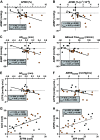Resistance exercise lowers blood pressure and improves vascular endothelial function in individuals with elevated blood pressure or stage-1 hypertension
- PMID: 37975709
- PMCID: PMC11219052
- DOI: 10.1152/ajpheart.00386.2023
Resistance exercise lowers blood pressure and improves vascular endothelial function in individuals with elevated blood pressure or stage-1 hypertension
Abstract
Lifestyle modifications are the first-line treatment recommendation for elevated blood pressure (BP) or stage-1 hypertension (E/S1H) and include resistance exercise training (RET). The purpose of the current study was to examine the effect of a 9-wk RET intervention in line with the current exercise guidelines for individuals with E/S1H on resting peripheral and central BP, vascular endothelial function, central arterial stiffness, autonomic function, and inflammation in middle-aged and older adults (MA/O) with untreated E/S1H. Twenty-six MA/O adults (54 ± 6 yr; 16 females/10 males) with E/S1H engaged in either 9 wk of 3 days/wk RET (n = 13) or a nonexercise control (Con; n = 13). Pre- and postintervention measures included peripheral and central systolic (SBP and cSBP) and diastolic BP (DBP and cDBP), flow-mediated dilation (FMD), carotid-femoral pulse wave velocity (cfPWV), cardiovagal baroreflex sensitivity (BRS), cardiac output (CO), total peripheral resistance (TPR), heart rate variability (HRV), and C-reactive protein (CRP). RET caused significant reductions in SBP {mean change ± 95% CI = [-7.9 (-12.1, -3.6) mmHg; P < 0.001]}, cSBP [6.8 (-10.8, -2.7) mmHg; P < 0.001)], DBP [4.8 (-10.3, -1.2) mmHg; P < 0.001], and cDBP [-5.1 (-8.9, -1.3) mmHg; P < 0.001]; increases in FMD [+2.37 (0.61, 4.14)%; P = 0.004] and CO [+1.21 (0.26, 2.15) L/min; P = 0.006]; and a reduction in TPR [-398 (-778, -19) mmHg·s/L; P = 0.028]. RET had no effect on cfPWV, BRS, HRV, or CRP relative to Con (P ≥ 0.20). These data suggest that RET reduces BP in MA/O adults with E/S1H alongside increased peripheral vascular function and decreased TPR without affecting cardiovagal function or central arterial stiffness.NEW & NOTEWORTHY This is among the first studies to investigate the effects of chronic resistance exercise training on blood pressure (BP) and putative BP regulating mechanisms in middle-aged and older adults with untreated elevated BP or stage-1 hypertension in a randomized, nonexercise-controlled trial. Nine weeks of resistance exercise training elicits 4- to 8-mmHg improvements in systolic and diastolic BP alongside improvements in vascular endothelial function and total peripheral resistance without influencing central arterial stiffness or cardiovagal function.
Keywords: aging; blood pressure; cardiovascular health; resistance exercise; vascular function.
Conflict of interest statement
No conflicts of interest, financial or otherwise, are declared by the authors.
Figures





References
-
- Lim SS, Vos T, Flaxman AD, Danaei G, Shibuya K, Adair-Rohani H , et al.. A comparative risk assessment of burden of disease and injury attributable to 67 risk factors and risk factor clusters in 21 regions, 1990-2010: a systematic analysis for the Global Burden of Disease Study 2010. Lancet 380: 2224–2260, 2012. [Erratum in Lancet 381: 1276, 2013]. doi:10.1016/S0140-6736(12)61766-8. - DOI - PMC - PubMed
-
- Williams B, Mancia G, Spiering W, Agabiti Rosei E, Azizi M, Burnier M, Clement DL, Coca A, de Simone G, Dominiczak A, Kahan T, Mahfoud F, Redon J, Ruilope L, Zanchetti A, Kerins M, Kjeldsen SE, Kreutz R, Laurent S, Lip GYH, McManus R, Narkiewicz K, Ruschitzka F, Schmieder RE, Shlyakhto E, Tsioufis C, Aboyans V, Desormais I; Authors/Task Force Members. 2018 ESC/ESH Guidelines for the management of arterial hypertension: the Task Force for the management of arterial hypertension of the European Society of Cardiology and the European Society of Hypertension. J Hypertens 36: 1953–2041, 2018. [Erratum in J Hypertens 37: 226, 2019]. doi:10.1097/HJH.0000000000001940. - DOI - PubMed
-
- Whelton PK, Carey RM, Aronow WS, Casey DE Jr, Collins KJ, Dennison Himmelfarb C, DePalma SM, Gidding S, Jamerson KA, Jones DW, MacLaughlin EJ, Muntner P, Ovbiagele B, Smith SC Jr, Spencer CC, Stafford RS, Taler SJ, Thomas RJ, Williams KA Sr, Williamson JD, Wright JT. Jr.. 2017 ACC/AHA/AAPA/ABC/ACPM/AGS/APhA/ASH/ASPC/NMA/PCNA guideline for the prevention, detection, evaluation, and management of high blood pressure in adults: executive summary: a report of the American College of Cardiology/American Heart Association Task Force on Clinical Practice Guidelines. Hypertension 71: 1269–1324, 2018. [Erratum in Hypertension 71: e140–e144, 2018]. doi:10.1161/HYP.0000000000000065. - DOI - PubMed
Publication types
MeSH terms
Grants and funding
LinkOut - more resources
Full Text Sources
Medical
Research Materials
Miscellaneous

